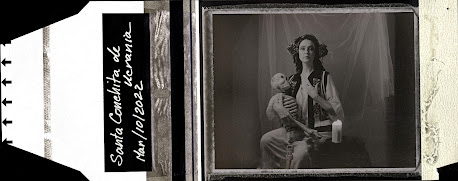 |
| Fuji Instant Colour Film peel (the negative reversed to positive) with Mamiya RB-67 |
In that past century I was an avid only film in camera photographer. It was my Rosemary who told me that I would have to stop bribing airport officials in Latin America who insisted on using X-rays on my film. And that is how I bought my first digital camera, a Fuji-X-E1 and later an X-E3.
That does not mean that I have abandoned film for the instant convenience of the digital camera. Some of my peers tell me that any photo I take with my digital camera can be converted to b+w, or high contrast. With Photoshop I can vignette or blur the edges, etc. There is even a tool in my Corel that can make any photograph resemble one taken with the now gone Kodak Infrared Film.
 |
| Colour Negative Film - Mamiya RB-67 |
My argument to counter that is that any photo I may take with my digital camera that I may convert to different versions are still the same photograph. These folks do not seem to get my point.
On the 9th my Ukrainian friend came over for a project where she was going to pose as a Ukrainian contemporary war Virgin Mary.
 |
| Fuji X-E3 |
For this shoot I used:
1. The Fuji X-E3 and I modified some of the shots by using a LensBaby lens.
2. A Mamiya RB-67 medium format camera in which one back had Kodak Portra Colour Negative film and the other Rollei b+w Infrared film.
3. On that Mamiya I put two different backs. One for Fuji Instant Colur and the other for Fuji Instant b+w.
4. I took some photographs with my iPhone3G (no SIM card).
 |
| Fuji Instant b+w Print Film with Mamiya |
I believe that in switching cameras both Olena and I got new ideas and different points of view.
 |
| Fuji Instant Colour Print Film with Mamiya |
 |
| iPhone3G |
 |
| Scanned Fuji b+w instant film peel negative reversed to positive |
 |
| Rollei Infrared Film in Mamiya RB-67 |
 |
| Fuji X-E3 with LensBaby |






